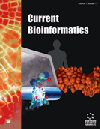- Home
- A-Z Publications
- Current Bioinformatics
- Previous Issues
- Volume 19, Issue 7, 2024
Current Bioinformatics - Volume 19, Issue 7, 2024
Volume 19, Issue 7, 2024
-
-
Metabolomics: Recent Advances and Future Prospects Unveiled
More LessAuthors: Shweta Sharma, Garima Singh and Mymoona AkhterIn the era of genomics, fueled by advanced technologies and analytical tools, metabolomics has become a vital component in biomedical research. Its significance spans various domains, encompassing biomarker identification, uncovering underlying mechanisms and pathways, as well as the exploration of new drug targets and precision medicine. This article presents a comprehensive overview of the latest developments in m Read More
-
-
-
An Explainable Multichannel Model for COVID-19 Time Series Prediction
More LessAuthors: Hongjian He, Jiang Xie, Xinwei Lu, Dingkai Huang and Wenjun ZhangIntroduction: The COVID-19 pandemic has affected every country and changed people's lives. Accurate prediction of COVID-19 trends can help prevent the further spread of the outbreak. However, the changing environment affects the COVID-19 prediction performance, and previous models are limited in practical applications. Methods: An explainable multichannel deep learning model with spatial, temporal and enviro Read More
-
-
-
DeepEpi: Deep Learning Model for Predicting Gene Expression Regulation Based on Epigenetic Histone Modifications
More LessAuthors: Rania Hamdy, Yasser Omar and Fahima MaghrabyBackground: Histone modification is a vital element in gene expression regulation. The way in which these proteins bind to the DNA impacts whether or not a gene may be expressed. Although those factors cannot influence DNA construction, they can influence how it is transcribed. Objective: Each spatial location in DNA has its function, so the spatial arrangement of chromatin modifications affects how the gene can Read More
-
-
-
Toxicity Prediction for Immune Thrombocytopenia Caused by Drugs Based on Logistic Regression with Feature Importance
More LessAuthors: Osphanie Mentari, Muhammad Shujaat, Hilal Tayara and Kil T. ChongBackground: One of the problems in drug discovery that can be solved by artificial intelligence is toxicity prediction. In drug-induced immune thrombocytopenia, toxicity can arise in patients after five to ten days by significant bleeding caused by drugdependent antibodies. In clinical trials, when this condition occurs, all the drugs consumed by patients should be stopped, although sometimes this is not possible, especially for Read More
-
-
-
Prediction of Super-enhancers Based on Mean-shift Undersampling
More LessAuthors: Han Cheng, Shumei Ding and Cangzhi JiaBackground: Super-enhancers are clusters of enhancers defined based on the binding occupancy of master transcription factors, chromatin regulators, or chromatin marks. It has been reported that super-enhancers are transcriptionally more active and cell-type-specific than regular enhancers. Therefore, it is necessary to identify super-enhancers from regular enhancers. A variety of computational methods have bee Read More
-
-
-
Discovering Microbe-disease Associations with Weighted Graph Convolution Networks and Taxonomy Common Tree
More LessAuthors: Jieqi Xing, Yu Shi, Xiaoquan Su and Shunyao WuBackground: Microbe-disease associations are integral to understanding complex diseases and their screening procedures. Objective: While numerous computational methods have been developed to detect these associations, their performance remains limited due to inadequate utilization of weighted inherent similarities and microbial taxonomy hierarchy. To address this limitation, we have introduced WTHMDA ( Read More
-
-
-
Stacking-Kcr: A Stacking Model for Predicting the Crotonylation Sites of Lysine by Fusing Serial and Automatic Encoder
More LessAuthors: Ying Liang, Suhui Li, Xiya You, You Guo and Jianjun TangBackground: Protein lysine crotonylation (Kcr), a newly discovered important posttranslational modification (PTM), is typically localized at the transcription start site and regulates gene expression, which is associated with a variety of pathological conditions such as developmental defects and malignant transformation. Objective: Identifying Kcr sites is advantageous for the discovery of its biological mechanism and the dev Read More
-
Volumes & issues
-
Volume 20 (2025)
-
Volume 19 (2024)
-
Volume 18 (2023)
-
Volume 17 (2022)
-
Volume 16 (2021)
-
Volume 15 (2020)
-
Volume 14 (2019)
-
Volume 13 (2018)
-
Volume 12 (2017)
-
Volume 11 (2016)
-
Volume 10 (2015)
-
Volume 9 (2014)
-
Volume 8 (2013)
-
Volume 7 (2012)
-
Volume 6 (2011)
-
Volume 5 (2010)
-
Volume 4 (2009)
-
Volume 3 (2008)
-
Volume 2 (2007)
-
Volume 1 (2006)
Most Read This Month
Article
content/journals/cbio
Journal
10
5
false
en


